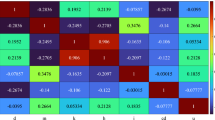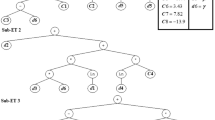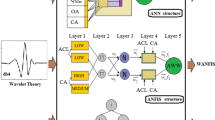Abstract
The hyporheic zone represents the interface between surface and subsurface flow. An experimental investigation was conducted in a laboratory flume featuring a maximum flow rate of 50 L per second, utilizing artificial grass completely submerged in water. Two sets of experiments were carried out, one with vegetation cover and the other without. The findings revealed that vegetation cover led to a reduction in hyporheic velocity, whereas the absence of vegetation increased hyporheic velocity. The study also noted that the absence of a hyporheic zone in vegetation, compared to gravel, could be attributed to the formation of a separation zone. Additionally, it was observed that vegetation cover facilitated the supply of more nutrients around the divide line, owing to upwelling flows from both upstream and downstream directions. Given the limited dataset, Soft Computing (SC) techniques, namely Wavelet-GEP (WGEP) and Gene Expression Programming (GEP), were employed to formulate mathematical equations for estimating hyporheic velocity under steady-state conditions for a given discharge. These equations, incorporating hydraulic and geomorphic variables, proved effective in estimating hyporheic velocity under stable bed conditions during steady flow. The models were trained and tested using 70% and 30% of the collected data, respectively. The performance of the models was assessed using statistical criteria. The results indicated a strong correlation between noise reduction in data and improved performance of the WGEP model compared to the GEP model in estimating velocity.







Similar content being viewed by others
Availability of Data and Materials
All data generated or analyzed during this study are included in this published article [and its Supplementary Information files].
References
Ahmadi A, Olyaei M, Heydari Z, Emami M, Zeynolabedin A, Ghomlaghi A, Sadegh M (2022) Groundwater level modeling with machine learning: a systematic review and meta-analysis. Water 14(6):949
Amini E, Mehdipour H, Faraggiana E, Golbaz D, Mozaffari S, Bracco G, Neshat M (2022) Optimization of hydraulic power take-off system settings for point absorber wave energy converter. Renew Energy 194:938–954. https://doi.org/10.1016/j.renene.2022.05.164
Azimi H, Shabanlou S, Ebtehaj I, Bonakdari H, Kardar S (2017) Combination of computational fluid dynamics, adaptive neuro-fuzzy inference system, and genetic algorithm for predicting discharge coefficient of rectangular side orifices. J Irrig Drain Eng 143:04017015. https://doi.org/10.1061/(ASCE)IR.1943-4774.0001190
Bagatur T, Onen F (2014) A predictive model on air entrainment by plunging water jets using GEP and ANN. KSCE J Civ Eng 18(1):304–314
Bagatur T, Onen F (2016) Computation of design coefficients in ogee-crested spillway structure using GEP and regression models. KSCE J Civ Eng 20(2):951–959. https://doi.org/10.1007/s12205-015-0648-x
Bahmani R, Solgi A, Ouarda TB (2020) Groundwater level simulation using gene expression programming and M5 model tree combined with wavelet transform. Hydrol Sci J 65(8):1430–1442. https://doi.org/10.1080/02626667.2020.1749762
Banks EW, Simmons CT, Love AJ, Shand P (2011) Assessing spatial and temporal connectivity between surface water and groundwater in a regional catchment: Implications for regional scale water quantity and quality. J Hydrol 404(1–2):30–49
Boulton AJ, Findlay S, Marmonier,P, Stanley EH, Valett HM (1998) The functional significance of the hyporheic zone in streams and rivers. Annu Rev Ecol Syst 59–81
Brunton SL, Hemati MS, Taira K (2020) Special issue on machine learning and data-driven methods in fluid dynamics. Theoret Comput Fluid Dyn 34(4):333–337
Buckingham E (1915) Model experiments and the forms of empirical equations. Trans ASME 37(263)
Buyukyildiz M, Kumcu SY (2017) An estimation of the suspended sediment load using adaptive network based fuzzy inference system, support vector machine and artificial neural network models. Water Resour Manage 31(4):1343–1359
Cao Z, Carling P, Oakey R (2003) Flow reversal over a natural pool–riffle sequence: a computational study. Earth Surf Process Landf 28(7):689–705. https://doi.org/10.1002/esp.466
Darbandi S, Pourhosseini FA (2018) River flow simulation using a multilayer perceptron-firefly algorithm model. Appl Water Sci 8(3):1–9
Ebrahimi H, Rajaee T (2017) Simulation of groundwater level variations using wavelet combined with neural network, linear regression and support vector machine. Glob Planet Change 148:181–191. https://doi.org/10.1016/j.gloplacha.2016.11.014
Emadi A, Sobhani R, Ahmadi H, Boroomandnia A, Zamanzad-Ghavidel S, Azamathulla HM (2022) Multivariate modeling of agricultural river water abstraction via novel integrated-wavelet methods in various climatic conditions. Environ Dev Sustain 24(4):4845–4871
Emadi A, Zamanzad-Ghavidel S, Sobhani R, Rashid-Niaghi A (2021) Multivariate modeling of groundwater quality using hybrid evolutionary soft-computing methods in various climatic condition areas of Iran. Aqua Water Infrastruct Ecosyst Soc 70(3):328–341. https://doi.org/10.2166/aqua.2021.150
Everard M, Powell A (2002) Rivers as living systems. Aquat Conserv Mar Freshwat Ecosyst 12(4):329–337
Fernando A, Shamseldin A, Abrahart R (2011) Comparison of two data-driven approaches for daily river flow forecasting. In: MODSIM2011, 19th International Congress on Modelling and Simulation, Perth, Australia, Modelling and Simulation Society of Australia and New Zealand
Ferreira C (2001) Gene expression programming: a new adaptive algorithm for solving problems. arXiv preprint cs/0102027. https://doi.org/10.48550/arXiv.cs/0102027
Ferreira C (2006) Gene expression programming: mathematical modeling by an artificial intelligence, vol 21
Fruetel C (2016) Analysis of hyporheic flow induced by a bar in a gravel stream: an experimental study (Doctoral dissertation)
Fruetel C, Mumford KG, Ferreira da Silva AM, Rey A, Bascom KS (2019) A laboratory method for the visualization and quantification of hyporheic flow paths and velocities. Can J Civ Eng 46(5):448–457
Ghorbani MA, Kazempour R, Chau KW, Shamshirband S, Taherei Ghazvinei P (2018) Forecasting pan evaporation with an integrated artificial neural network quantum-behaved particle swarm optimization model: a case study in Talesh, Northern Iran. Eng Appl Comput Fluid Mech 12(1):724–737
Haghbin M, Sharafati A (2022) A review of studies on estimating the discharge coefficient of flow control structures based on the soft computing models. Flow Meas Instrum 102119
Hakenkamp CC, Palmer MA (2000) The ecology of hyporheic meiofauna. Streams Ground Waters 307–336
Herzog SP, Higgins CP, McCray JE (2016) Engineered streambeds for induced hyporheic flow: Enhanced removal of nutrients, pathogens, and metals from urban streams. J Environ Eng 142(1):04015053
Hohensinner S, Hauer C, Muhar S (2018) River morphology, channelization, and habitat restoration. In: Riverine ecosystem management. Springer, Cham, pp 41–65
Huang S, Yang JQ (2022) Impacts of emergent vegetation on hyporheic exchange. Geophys Res Lett 49(13):e2022GL099095. https://doi.org/10.1029/2022GL099095
Kabiri F, Afzalimehr H, Sui J (2017) Flow structure over a wavy bed with vegetation cover. Int J Sedim Res 32(2):186–194
Kabiri F, Tabatabai MRM, Shayannejad M (2022a) Effect of vegetative bed on flow structure through a pool-riffle morphology. Flow Meas Instrum 102197
Kabiri F, Tabatabai MRM, Shayannejad M (2022b) Effect of vegetation cover on hyporheic velocity and phosphorus removal in a pool-riffle sequence. In: 14th International Symposium on Ecohydraulics (ISE 2022)
Khalaj M, Kholghi M, Saghafian B, Bazrafshan J (2019) Impact of climate variation and human activities on groundwater quality in northwest of Iran. J Water Supply Res Technol Aqua 68(2):121–135
Khan M, Azamathulla HM, Tufail M (2012) Gene-expression programming to predict pier scour depth using laboratory data. J Hydroinf 14(3):628–645
Khan MS, Coulibaly P (2006) Application of support vector machine in lake water level prediction. J Hydrol Eng 11(3):199–205. https://doi.org/10.1061/(ASCE)1084-0699(2006)11:3(199)
Kisi O, Shiri J (2012) Wavelet and neuro-fuzzy conjunction model for predicting water table depth fluctuations. Hydrol Res 43(3):286–300. https://doi.org/10.2166/nh.2012.104b
Kisi O, Shiri J, Nazemi AH (2011) A wavelet-genetic programming model for predicting short-term and long-term air temperatures. J Civil Eng Urban 1:25–37
Kumar M, Kumar P, Kumar A, Elbeltagi A, Kuriqi A (2022) Modeling stage–discharge–sediment using support vector machine and artificial neural network coupled with wavelet transform. Appl Water Sci 12(5):1–21. https://doi.org/10.1007/s13201-022-01621-7
Kumari A, Kumar A, Kumar M, Kuriqi A (2022) Modeling average grain velocity for rectangular channel using soft computing techniques. Water 14(9):1325. https://doi.org/10.3390/w14091325
Labat D, Ronchail J, Guyot JL (2005) Recent advances in wavelet analyses: Part 2—Amazon, Parana, Orinoco and Congo discharges time scale variability. J Hydrol 314(1–4):289–311. https://doi.org/10.1016/j.jhydrol.2005.04.004
Li Z, Sun Z, Liu J, Dong H, Xiong W, Sun L, Zhou H (2022) Prediction of river sediment transport based on wavelet transform and neural network model. Appl Sci 12(2):647. https://doi.org/10.3390/app12020647
Liu S, Chui TFM (2018) Impacts of streambed heterogeneity and anisotropy on residence time of hyporheic zone. Groundwater 56(3):425–436
Lu C, Ji K, Wang W, Zhang Y, Ealotswe TK, Qin W, Shu L (2021) Estimation of the interaction between groundwater and surface water based on flow routing using an improved nonlinear muskingum-cunge method. Water Resour Manage 35(8):2649–2666. https://doi.org/10.1007/s11269-021-02857-9
Lu C, Ji K, Zhang Y, Fleckenstein JH, Zheng C, Salsky K (2020) Event-driven hyporheic exchange during single and seasonal rainfall in a gaining stream. Water Resour Manage 34:4617–4631. https://doi.org/10.1007/s11269-020-02678-2
Lu X, Wang X, Zhang L, Zhang T, Yang C, Song X, Yang Q (2018) Improving forecasting accuracy of river flow using gene expression programming based on wavelet decomposition and de-noising. Hydrol Res 49(3):711–723. https://doi.org/10.2166/nh.2017.115
Mohammadrezapour O, Piri J, Kisi O (2019) Comparison of SVM, ANFIS and GEP in modeling monthly potential evapotranspiration in an arid region (Case study: Sistan and Baluchestan Province, Iran). Water Supply 19(2):392–403
Mohanta A, Pradhan A, Patra KC (2022) Determination of discharge distribution in meandering compound channels using machine learning techniques. J Irrig Drain Eng 148(1):04021063
Montaseri M, Ghavidel ZZS, Sanikhani H (2018) Water quality variations in different climates of Iran: toward modeling total dissolved solid using soft computing techniques. Stoch Env Res Risk Assess 32(8):2253–2273
Mozaffari S, Amini E, Mehdipour H, Neshat M (2022) Flow discharge prediction study using a CFD-based numerical model and gene expression programming. Water 14(4):650. https://doi.org/10.3390/w1404065
Mueller BM, Schulz H, Meinikmann K, Lewandowski J (2019) Biogeochemical milieu and attenuation of trace organics in the hyporheic zone of an urban river with short-term discharge fluctuations. In: Geophysical research abstracts, vol 21
Namour P, Schmitt L, Eschbach D, Moulin B, Fantino G, Bordes C, Breil P (2015) Stream pollution concentration in riffle geomorphic units (Yzeron basin, France). Sci Total Environ 532:80–90. https://doi.org/10.1016/j.scitotenv.2015.05.057
Partal T, Cigizoglu HK (2008) Estimation and forecasting of daily suspended sediment data using wavelet–neural networks. J Hydrol 358(3–4):317–331. https://doi.org/10.1016/j.jhydrol.2008.06.013
Roushangar K, Chamani M, Ghasempour R, Azamathulla HM, Alizadeh F (2021) A comparative study of wavelet and empirical mode decomposition-based GPR models for river discharge relationship modeling at consecutive hydrometric stations. Water Supply 21(6):3080–3098
Roushangar K, Shahnazi S (2020) Prediction of sediment transport rates in gravel-bed rivers using Gaussian process regression. J Hydroinf 22(2):249–262. https://doi.org/10.2166/hydro.2019.077
Rupprecht F, Möller I, Evans B, Spencer T, Jensen K (2015) Biophysical properties of salt marsh canopies—Quantifying plant stem flexibility and above ground biomass. Coast Eng 100:48–57
Sandercock PJ, Hooke JM (2010) Assessment of vegetation effects on hydraulics and of feedbacks on plant survival and zonation in ephemeral channels. Hydrol Process 24(6):695–713
Seo Y, Kim S, Kisi O, Singh VP (2015) Daily water level forecasting using wavelet decomposition and artificial intelligence techniques. J Hydrol 520:224–243
Seppelt R, Lautenbach S, Volk M (2013) Identifying trade-offs between ecosystem services, land use, and biodiversity: a plea for combining scenario analysis and optimization on different spatial scales. Curr Opin Environ Sustain 5(5):458–463
Shaghaghi S, Bonakdari H, Gholami A, Kisi O, Binns A, Gharabaghi B (2019) Predicting the geometry of regime rivers using M5 model tree, multivariate adaptive regression splines and least square support vector regression methods. Int J River Basin Manag 17(3):333–352
Shah MI, Alaloul WS, Alqahtani A, Aldrees A, Musarat MA, Javed MF (2021) Predictive modeling approach for surface water quality: development and comparison of machine learning models. Sustainability 13(14):7515
Sharghi E, Nourani V, Najafi H, Soleimani S (2019) Wavelet-exponential smoothing: a new hybrid method for suspended sediment load modeling. Environ Process 6:191–218. https://doi.org/10.1007/s40710-019-00363-0
Taylor KE (2001) Summarizing multiple aspects of model performance in a single diagram. J Geophys Res Atmos 106(D7):7183–7192
Tonina D (2005) Interaction between river morphology and intra-gravel flow paths within the hyporheic zone. University of Idaho
Tonina D, Buffington JM (2007) Hyporheic exchange in gravel bed rivers with pool‐riffle morphology: Laboratory experiments and three‐dimensional modeling. Water Resour Res 43(1)
Tonina D, Buffington JM (2009) Hyporheic exchange in mountain rivers I: Mechanics and environmental effects. Geogr Compass 3(3):1063–1086
Vargas-Luna A, Crosato A, Uijttewaal WS (2015) Effects of vegetation on flow and sediment transport: comparative analyses and validation of predicting models. Earth Surf Proc Land 40(2):157–176
Vargas-Luna A, Duró G, Crosato A, Uijttewaal W (2019) Morphological adaptation of river channels to vegetation establishment: A laboratory study. J Geophys Res Earth Surf 124(7):1981–1995
Wang Y, Yuan Y, Pan Y, Fan Z (2020) Modeling daily and monthly water quality indicators in a canal using a hybrid wavelet-based support vector regression structure. Water 12(5):1476–1497. https://doi.org/10.3390/w12051476
Wu J, Wang Z (2022) A hybrid model for water quality prediction based on an artificial neural network, wavelet transform, and long short-term memory. Water 14(4):610
Yousefi P, Shabani S, Mohammadi H, Naser G (2017) Gene expression programing in long term water demand forecasts using wavelet decomposition. Procedia Eng 186:544–550. https://doi.org/10.1016/j.proeng.2017.03.268
Yu H, Wen X, Feng Q, Deo RC, Si J, Wu M (2018) Comparative study of hybrid-wavelet artificial intelligence models for monthly groundwater depth forecasting in extreme arid regions, Northwest China. Water Resour Manage 32:301–323. https://doi.org/10.1007/s11269-017-1811-6
Zamanzad-Ghavidel S, Fazeli S, Mozaffari S, Sobhani R, Hazi MA, Emadi A (2022) Estimating of aqueduct water withdrawal via a wavelet-hybrid soft-computing approach under uniform and non-uniform climatic conditions. Environ Dev Sustain 1–32. https://doi.org/10.1007/s10668-022-02265-y
Zamanzad-Ghavidel S, Sobhani R, Etaei S, Hosseini Z, Montaseri M (2021) Development of hydro-social-economic-environmental sustainability index (HSEESI) in integrated water resources management. Environ Monit Assess 193(8):1–29. https://doi.org/10.1007/s10661-021-09129-4
Zare M, Koch M (2018) Groundwater level fluctuations simulation and prediction by ANFIS-and hybrid Wavelet-ANFIS/Fuzzy C-Means (FCM) clustering models: Application to the Miandarband plain. J Hydro Environ Res 18:63–76. https://doi.org/10.1016/j.jher.2017.11.004
Zarnetske JP, Haggerty R, Wondzell SM, Baker MA (2011) Dynamics of nitrate production and removal as a function of residence time in the hyporheic zone. J Geophys Res Biogeosci 116(G1)
Zhang J, Song J, Long Y, Zhang Y, Zhang B, Wang Y, Wang Y (2017) Quantifying the spatial variations of hyporheic water exchange at catchment scale using the thermal method: A case study in the Weihe River, China. Adv Meteorol 2017
Zhao B, Zhang L, Xia Z, Xu W, Xia L, Liang Y, Xia D (2019) Effects of rainfall intensity and vegetation cover on erosion characteristics of a soil containing rock fragments slope. Adv Civil Eng 2019
Zounemat-Kermani M, Seo Y, Kim S, Ghorbani MA, Samadianfard S, Naghshara S, Singh VP (2019) Can decomposition approaches always enhance soft computing models? Predicting the dissolved oxygen concentration in the St. Johns River, Florida. Appl Sci 9(12):2534
Funding
The authors declare that no funds, grants, or other supports were received during the preparation of this manuscript.
Author information
Authors and Affiliations
Contributions
F. K.: Conceptualization, Methodology, Writing—original draft preparation, Formal analysis and investigation. M. R. M. T.: Supervision, Conceptualization, Writing—review and editing. S. M.: Methodology, Formal analysis and investigation. M. S.: Supervision.
Corresponding author
Ethics declarations
Ethical Approval
All research activities conducted for this article have obtained ethical approval from the relevant institutional review board or ethics committee. This ensures that the research complies with ethical standards and safeguards the rights and well-being of the participants.
Consent to Participate
Participants involved in this study have provided informed consent to voluntarily participate. Clear and comprehensive information regarding the study's purpose, procedures, and potential risks has been communicated, allowing participants to make informed decisions about their involvement.
Consent to Publish
Authors have obtained explicit consent from study participants, when applicable, for the publication of any identifiable information. This ensures respect for individuals' privacy and confidentiality, aligning with ethical publishing practices.
Competing Interests
Authors disclose any competing interests that could influence the interpretation or presentation of the research. This includes financial interests, relationships, or affiliations that may be perceived as influencing the work.
Additional information
Publisher's Note
Springer Nature remains neutral with regard to jurisdictional claims in published maps and institutional affiliations.
Supplementary Information
Below is the link to the electronic supplementary material.
Rights and permissions
Springer Nature or its licensor (e.g. a society or other partner) holds exclusive rights to this article under a publishing agreement with the author(s) or other rightsholder(s); author self-archiving of the accepted manuscript version of this article is solely governed by the terms of such publishing agreement and applicable law.
About this article
Cite this article
Kabiri, F., Tabatabai, M.R.M., Mozaffari, S. et al. Experimental Study to Estimate Hyporheic Velocity Using Wavelet-Hybrid Soft-Computing Model. Water Resour Manage 38, 915–933 (2024). https://doi.org/10.1007/s11269-023-03701-y
Received:
Accepted:
Published:
Issue Date:
DOI: https://doi.org/10.1007/s11269-023-03701-y




